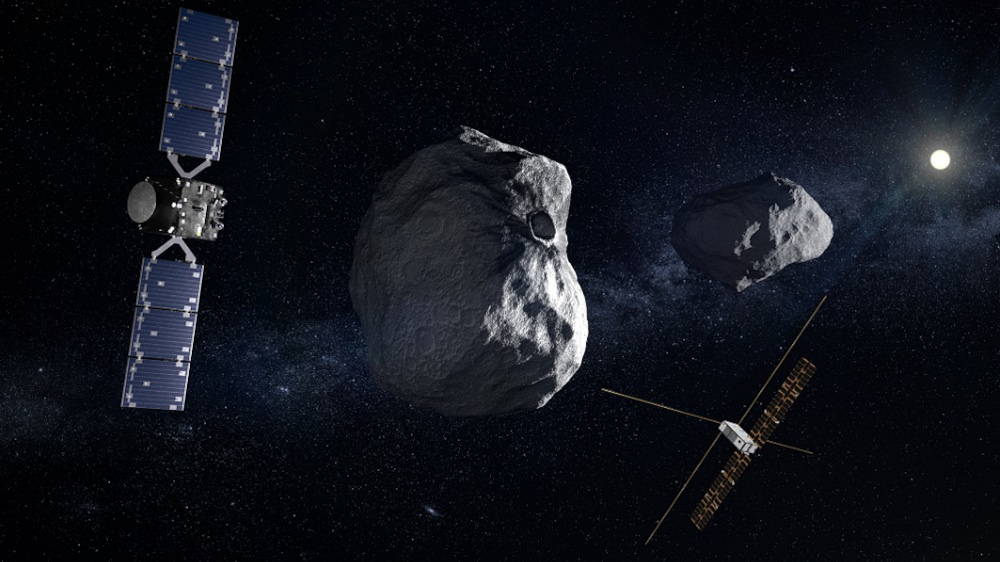
Hera space mission provides data for planetary defence and space mining
In October 2024, Finnish technology was launched into outer space with the Hera space mission. What do planetary defence and space mining mean? Can Earth be protected from collisions with asteroids? And when will the first mining on an asteroid be established?
The European Space Agency ESA's Hera probe was launched on 7 October 2024 towards the Didymos binary asteroid, 195 million km away. The mission will investigate the crater caused by the impact of the US Space Agency NASA's DART probe on the asteroid in September 2022. The Hera space mission aims to provide new research data for future developments in planetary defence and space mining.

Planetary defence – can Earth be protected from the impact of asteroids?
Planetary defence is a field of research that seeks to find, track and understand asteroids and comets that may threaten Earth, and to help humanity prevent them from colliding with the Earth. A collision could be prevented, for example, by destroying the threatening asteroid or changing its orbit.
Small asteroids are constantly entering Earth's atmosphere, but they do not pose a significant threat to its ecosystems. Large asteroids over a kilometre in diameter, on the other hand, could cause a global catastrophe if they hit our Earth – the asteroid that destroyed dinosaurs 66 million years ago was about ten kilometres in diameter. So far, there are no known asteroids larger than 140 m in diameter that have a significant chance of colliding with Earth in the next hundred years. However, we are currently able to track only small fraction of all asteroids that threaten Earth.

Internationally, planetary defence is being promoted by many actors. ESA and NASA maintain their own catalogues of Near-Earth Objects (NEOs) that could potentially collide with Earth. The world's best telescopes search for such targets and constantly monitor the situation, both from Earth and from space, to detect threats as early as possible. NASA's DART (Double Asteroid Redirection Test) mission was the first planetary defence space mission to test whether the orbit of an asteroid could be altered by colliding with the asteroid.
Planetary defence is warfare against the threats of space and, in war, a good knowledge of the enemy is a prerequisite for success. A lot more research is needed to combat asteroids that could potentially threaten the Earth. For a probe to impact an asteroid in a controlled way, at the right speed, time and angle, we need to know how the asteroid will react to the impact: how its orbit will change and how much material will be shed from its surface. This requires both basic research into the material composition and internal structure of asteroids and information about the mass, shape and physical state of the actual asteroid on collision course with the Earth. The Hera mission will provide essential observations to build such knowledge.

Mining in space – the salvation of humanity as natural resources run out?
Because Earth’s critical mineral resources are limited, some mining companies have begun to look to space. The Moon or some near-Earth asteroids have great mineral potential.
One of the most advanced companies is the US company TransAstra, which has already outlined how and with what equipment asteroids could be mined profitably. The company has also tested optical extraction, which uses concentrated sunlight to capture gas from the surfaces of asteroids, moons and planets rich in volatiles. Another space mining company, AstroForge, has the ambitious goal of having the first batches of material mined from space on sale by the end of the 2020s. For the time being, however, mining in space is still a long way off.
But before space mining becomes a reality, a number of challenges related to energy, water, logistics and infrastructure need to be addressed. Asteroids have almost no gravity, so machines and miners would have to anchor themselves to the asteroid. The lack of gravity, however, is also an advantage as the extracted material could be easily moved.

Research data collected with telescopes and cameras
Much more research data is also needed on asteroids. For reasons of high cost, the asteroids with the highest potential must be identified beforehand remotely prior any detailed examination on the asteroid surface occurs. This could be done, for example, using advanced telescopes and hyperspectral camera technology on test probes, which will also be tested in the Hera mission.
For example, more research is needed on how millions of years of exposure to space have affected the reflective properties of different minerals. New data can also be collected and hyperspectral cameras tested by studying in a laboratory meteorites that have already fallen to Earth.
There are also legal issues to be resolved: According to the UN Outer Space Treaty, outer space and its resources cannot be owned by any single entity alone, but must be shared by humanity. Asteroids and lunar surface must be looked also from natural heritage perspective. Any surface operations or resource utilization produce irreversible damage to the space bodies. Space resource exploration and must be done responsibly and exploitation only under strong valid justification in order to preserve our Solar System environment to future generations.
The Hera space mission involves an ASPECT hyperspectral camera developed by VTT to study the mineral composition of asteroids. The Aalto University and University of Helsinki are responsible for the data processing, equipment testing and scientific planning of the operation. The hyperspectral camera's data processing unit was designed by the Finnish company Kuva Space.
More information about the Hera mission
Sources:
https://science.nasa.gov/planetary-science/programs/planetarydefense/
https://www.space.com/planetary-defense-explained
https://www.space.com/space-mining-grinding-into-reality
https://www.mining-technology.com/features/can-asteroid-mining-be-profitable-astroforge-is-counting-on-it/?cf-view
Image credits: ESA




